Koi ponds in St. Louis require specific maintenance to thrive in our local climate. Are you struggling to keep your koi healthy and your pond pristine? This guide covers essential techniques for water quality testing, filtration, cleaning, and fish care. Learn how to protect your koi from predators and manage pond plants effectively. By following these methods, you’ll create a healthier environment for your koi and enjoy a beautiful water feature. Clarity Ponds offers expert advice on dedicated koi ponds and water feature repair to help you maintain your aquatic oasis.
Implement Regular Water Quality Testing for Healthy Koi
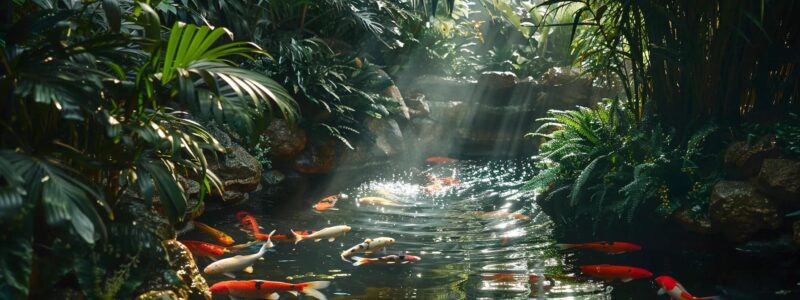
Regular water quality testing is crucial for maintaining healthy koi in dedicated koi ponds. This section covers using test kits for pH, ammonia, and nitrites, adjusting parameters based on results, and scheduling bi-weekly tests. It also addresses monitoring seasonal changes, logging readings, and understanding plant life’s impact on water chemistry. Proper testing helps manage ultraviolet exposure, oxygen saturation, algae growth, cloud formation, and foam accumulation. For more information, contact us.
Use Test Kits to Measure pH, Ammonia, and Nitrites
Using test kits to measure pH, ammonia, and nitrites is essential for maintaining optimal water clarity and koi health in dedicated koi ponds in St. Louis. These tests help pond owners monitor the delicate balance of beneficial bacteria and minerals in the water, ensuring a thriving ecosystem for koi and other aquatic life. Regular testing allows for early detection of imbalances, enabling prompt adjustments to the landscape or water chemistry before issues escalate, potentially saving time and resources in the long run. For more information, contact us.
Adjust Water Parameters Based on Test Results
Adjusting water parameters based on test results is crucial for maintaining a healthy koi pond environment in St. Louis. When water quality tests indicate imbalances, pond owners should take prompt action to correct issues. This may involve adding beneficial nitrifying bacteria to reduce ammonia levels, using an algaecide to control excessive algae growth, or adjusting pH levels with appropriate additives. Regular adjustments help prevent toxicity and ensure optimal conditions for dedicated koi ponds and other aquatic life, including beneficial organisms like oysters that contribute to natural water filtration and clarity ponds:
| Parameter | Ideal Range | Adjustment Method |
|---|---|---|
| pH | 7.0 – 8.5 | Add pH increaser or decreaser |
| Ammonia | 0 ppm | Increase filtration, add nitrifying bacteria |
| Nitrites | 0 ppm | Partial water change, add beneficial bacteria |
Schedule Testing Every Two Weeks for Optimal Koi Health
Scheduling water quality tests every two weeks is crucial for maintaining optimal koi health in St. Louis dedicated koi ponds. Regular testing allows pond owners to monitor changes in water parameters, especially in bogs and planted areas, which can significantly impact fish well-being. This consistent schedule helps detect potential issues early, such as carbon buildup or imbalances in the ecosystem, enabling prompt water feature repair. As a helpful tip, pond enthusiasts should create a testing calendar and log results to track trends over time, ensuring a thriving environment for their prized koi.
Monitor Seasonal Changes Affecting Water Quality
Monitoring seasonal changes is crucial for maintaining water quality in St. Louis koi ponds. As temperatures fluctuate, nitrogen cycles, fish digestion rates, and light exposure vary, impacting overall pond health. Pond owners should adjust their testing frequency and parameters based on these seasonal shifts, paying particular attention to heat stress in summer and reduced bacterial activity in winter. Regular monitoring helps maintain optimal conditions for koi, ensuring their well-being throughout the year:
| Season | Key Factors | Recommended Actions |
|---|---|---|
| Spring | Increased light, warming water | Monitor ammonia levels, increase feeding gradually |
| Summer | High heat, increased metabolism | Check oxygen levels, manage algae growth |
| Fall | Cooling water, leaf debris | Reduce feeding, remove debris regularly |
| Winter | Cold temperatures, reduced activity | Maintain water movement, test less frequently |
Keep a Log of Water Quality Readings Over Time
Maintaining a detailed log of water quality readings over time is essential for effective koi pond management in St. Louis. By tracking parameters such as pH, ammonia, and nitrite levels, pond owners can identify trends and potential issues before they become problematic. This practice allows for timely adjustments to filtration systems, including zeolite media and clay-based substrates, which play crucial roles in nutrient management. Regular logging also helps optimize pump performance and garden integration, ensuring a harmonious balance between the pond ecosystem and surrounding landscape.
Understand the Impact of Plant Life on Water Chemistry
Understanding the impact of plant life on water chemistry is crucial for maintaining healthy koi ponds in St. Louis. Plants play a vital role in nutrient absorption, helping to control algae growth and balance water parameters. However, excessive plant growth can lead to fungus issues, requiring careful management. Pond owners should monitor plant health regularly, using API test kits to check water quality and adjust salt levels as needed. Proper plant maintenance, including pruning and removal of dead foliage, helps prevent debris from clogging fountains and check valves, ensuring optimal water circulation and oxygenation:
- Monitor plant growth and health
- Use API test kits for water quality checks
- Adjust salt levels as necessary
- Prune and remove dead plant material
- Maintain fountains and check valves for proper circulation
Maintain Proper Filtration Systems for Koi Ponds
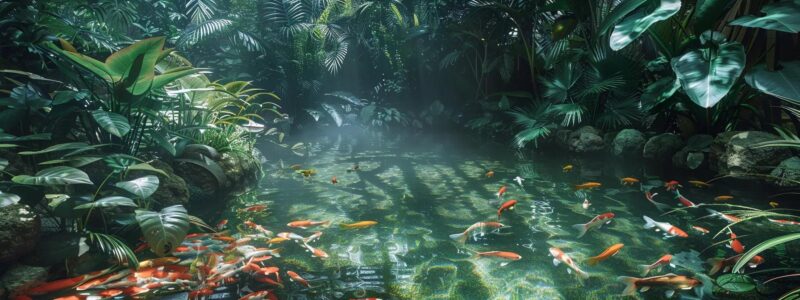
Proper filtration systems are essential for maintaining healthy koi ponds in St. Louis. This section covers selecting appropriate filtration based on pond size, regular cleaning, media replacement, pump maintenance, optimal water circulation, and using beneficial bacteria. Effective filtration, including bead and phosphate removal systems, along with barley and tank treatments, ensures optimal koi pond water quality.
Choose the Right Filtration System Based on Pond Size
Selecting the appropriate filtration system based on pond size is crucial for maintaining optimal water quality in St. Louis koi ponds. Larger ponds require more powerful filtration systems to handle the increased water volume and fish waste. Pond owners should consider factors such as flow rate, media capacity, and the ability to adjust salinity levels when choosing a filtration system. Proper filtration helps maintain stable water parameters, reducing the need for frequent pond salt additions and ensuring efficient removal of debris through strategically placed valves.
Clean Filters Regularly to Ensure Efficient Operation
Regular filter cleaning is essential for maintaining efficient koi pond filtration systems in St. Louis. Pond owners should remove debris from filters weekly, paying attention to areas where lawn clippings may accumulate. This practice helps prevent water quality issues and ensures proper chemistry balance. For optimal results, professionals recommend using wheat-based filter media, which offers excellent filtration while being environmentally friendly. By following these tips, koi enthusiasts can maintain crystal-clear water and healthy fish.
Replace Filter Media as Recommended by the Manufacturer
Replacing filter media as recommended by the manufacturer is crucial for maintaining optimal water quality in St. Louis koi ponds. Regular replacement helps prevent stress on fish and ensures efficient removal of debris and harmful substances. Pond owners should follow manufacturer guidelines for media replacement, which typically ranges from 6 to 12 months depending on pond conditions. Using a water conditioner during media changes can help maintain crystal-clear water and protect goldfish and koi from sudden parameter shifts. Proper maintenance, including backwashing when necessary, extends the life of filtration systems and promotes a healthier pond environment:
- Follow manufacturer guidelines for replacement intervals
- Use water conditioner during media changes
- Perform backwashing as needed
- Monitor water clarity and fish behavior
- Keep spare media on hand for emergencies
Inspect Pump Performance and Upgrade When Necessary
Regular inspection of pump performance is crucial for maintaining a healthy koi pond ecosystem in St. Louis. Pond owners should monitor their pumps for signs of decreased efficiency, unusual noise, or reduced water flow, which may indicate issues with soil accumulation or waste buildup. Upgrading pumps when necessary ensures optimal filtration, preventing the spread of disease and maintaining proper oxygen levels. By investing in high-quality pumps designed to handle organic matter effectively, koi enthusiasts can create a thriving environment for their prized fish while minimizing maintenance efforts.
Position Inlets and Outlets for Effective Water Circulation
Proper positioning of inlets and outlets is crucial for effective water circulation in St. Louis koi ponds. Strategically placed inlets and outlets ensure optimal distribution of filtered water, reducing areas of high nitrite concentration and preventing debris accumulation. Pond owners should position outlets to create a gentle current that guides floating debris toward skimmers, while inlets should be placed to promote even distribution of calcium and other essential minerals. This careful arrangement helps maintain water quality by minimizing metal buildup and ensuring efficient filtration throughout the pond:
- Place inlets at opposite ends of the pond
- Position outlets near the surface for improved gas exchange
- Install bottom drains to remove settled debris
- Use multiple inlets for larger ponds to ensure even distribution
- Consider adding water features to enhance circulation
Use Beneficial Bacteria to Promote Healthy Filtration
Using beneficial bacteria promotes healthy filtration in St. Louis koi ponds by enhancing the biological breakdown of waste and maintaining water quality. Pond owners can introduce enzyme-rich bacterial cultures to their filtration systems, which colonize gravel and other filter media, creating a natural cleaning process. These microorganisms efficiently convert harmful ammonia and nitrites into less toxic compounds, reducing the need for frequent water changes and minimizing stress on fish. For optimal results, pond enthusiasts should consider using bentonite clay as a substrate in their filtration systems, as it provides an excellent surface for beneficial bacteria to thrive while also helping to clarify water by trapping suspended particles.
Ensure Regular Pond Cleaning to Keep Koi Healthy
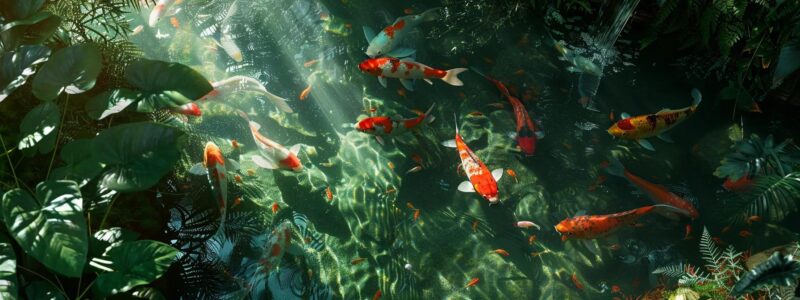
Regular pond cleaning is essential for maintaining healthy koi in St. Louis. This section covers developing a cleaning schedule, removing debris, using pond vacuums, cleaning decorative features, performing water changes, and controlling algae. Proper maintenance ensures optimal water quality, supports the natural environment, and keeps mechanical filters and sponges functioning efficiently, promoting oxygen levels for thriving koi.
Develop a Cleaning Schedule for Pond Maintenance Tasks
Developing a cleaning schedule for koi pond maintenance tasks is crucial for maintaining a healthy aquatic environment in St. Louis. Pond owners should establish a routine that includes weekly checks of the biofilter, monthly testing of ammonia levels, and quarterly deep cleanings of the fish pond. Regular maintenance helps prevent water quality issues and ensures the koi pond remains a thriving ecosystem. When performing water changes, it’s important to use dechlorinated tap water to protect the delicate balance of beneficial bacteria in the pond:
| Frequency | Task | Importance |
|---|---|---|
| Weekly | Check biofilter | Ensures efficient filtration |
| Monthly | Test ammonia levels | Prevents toxic buildup |
| Quarterly | Deep clean fish pond | Removes accumulated debris |
| As needed | Partial water changes | Maintains water quality |
Remove Debris and Leaves to Prevent Water Quality Issues
Regular removal of debris and leaves from koi ponds in St. Louis is crucial for maintaining optimal water quality. Accumulated organic matter can lead to increased nitrate levels and promote algae growth, potentially harming koi health. Pond owners should use nets or skimmers to remove floating debris weekly, paying special attention during fall when leaf litter is abundant. To combat excessive evaporation and maintain water clarity, pond enthusiasts can employ aquarium-grade clarifiers and consider using herbicides judiciously to control unwanted aquatic plant growth:
| Debris Type | Removal Method | Frequency |
|---|---|---|
| Floating leaves | Net skimming | Daily (fall), Weekly (other seasons) |
| Submerged debris | Pond vacuum | Monthly |
| Algae buildup | Algae scrubber | Bi-weekly |
| Organic sludge | Sludge remover | Quarterly |
Use a Pond Vacuum to Clean the Bottom Efficiently
Using a pond vacuum efficiently cleans the bottom of koi ponds in St. Louis, removing accumulated debris and maintaining a healthy ecosystem. Pond owners should employ vacuums with adjustable suction power to avoid disturbing the natural lake-like environment while effectively removing waste. Regular vacuuming helps maintain freshwater conditions, reducing the need for frequent air pump usage and supporting the pond’s delicate balance. Pond enthusiasts can optimize their cleaning routine by following this schedule:
| Pond Size | Vacuuming Frequency | Time per Session |
|---|---|---|
| Small (up to 500 gallons) | Bi-weekly | 15-30 minutes |
| Medium (500-2000 gallons) | Monthly | 30-60 minutes |
| Large (2000+ gallons) | Quarterly | 1-2 hours |
Clean the Fountain and Decorative Features Periodically
Periodic cleaning of fountains and decorative features is essential for maintaining a healthy koi pond ecosystem in St. Louis. Owners should regularly inspect these elements for signs of leaks, which can disrupt the nitrogen cycle and affect pH levels. Using a mild acid solution to remove mineral deposits ensures proper water flow and filtration efficiency. A thorough cleaning schedule helps prevent algae buildup and maintains optimal water quality for koi:
- Check for leaks monthly
- Clean fountains bi-weekly
- Remove debris from decorative features weekly
- Test pH levels after cleaning
- Adjust filtration as needed
Perform Partial Water Changes to Refresh Pond Water
Performing partial water changes refreshes koi ponds in St. Louis by removing accumulated sludge and excess organic matter. Pond owners should replace 10-15% of the water weekly, using dechlorinated water to protect beneficial bacteria in the water garden. This practice helps maintain proper carbon dioxide levels and removes harmful substances, ensuring a healthy environment for koi. When refilling, owners should use a carbon filter to remove chlorine and other contaminants, promoting optimal water quality for thriving fish and plants.
Assess the Need for Algae Control Methods When Needed
Assessing the need for algae control methods is crucial for maintaining a healthy koi pond ecosystem in St. Louis. Pond owners should monitor water clarity and odor, as excessive algae growth can impair the pond’s beauty and disrupt the nitrification process. When algae blooms occur, specialists recommend using calcium carbonate to adjust pH levels, which can help control algae while supporting the koi’s immune system. Regular water testing and observation of fish behavior are essential for determining when algae control measures are necessary, ensuring a balanced and thriving aquatic environment.
Provide the Right Nutrition for Your Koi Fish
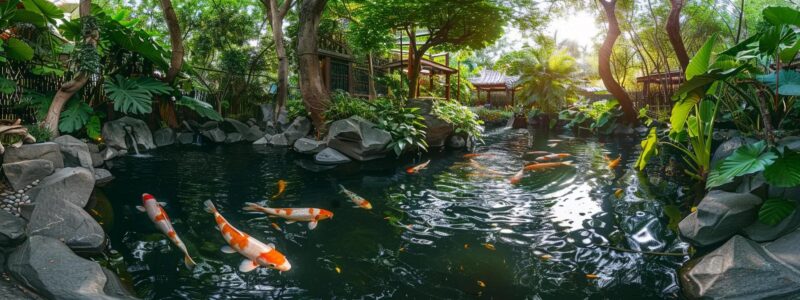
Providing proper nutrition is essential for maintaining healthy koi in St. Louis ponds. This section covers selecting high-quality food, feeding based on age and size, avoiding overfeeding, adjusting diets seasonally, monitoring behavior, and offering treats sparingly. Proper nutrition supports optimal growth, water quality, and overall pond health, including maintaining proper pressure in waterfalls and redox balance in garden ponds.
Choose High-Quality Koi Food for Optimal Growth
Selecting high-quality koi food is essential for optimal growth and health in St. Louis ponds. Pond owners should choose nutrient-rich formulas that support proper aeration and maintain alkalinity levels in the water. Quality food helps prevent digestive issues and promotes vibrant colors in koi, while also reducing waste that can affect water quality. When selecting food, pond enthusiasts should consider their koi’s age, size, and nutritional requirements, ensuring the food contains appropriate protein levels and essential vitamins. For convenience, many suppliers offer subscription services, allowing pond owners to have quality food delivered regularly to their email address.
Feed Koi According to Their Age and Size
Feeding koi according to their age and size is crucial for maintaining healthy fish in St. Louis ponds. Young koi require more frequent, protein-rich meals to support rapid growth, while adult koi need less frequent feeding with a balanced diet. Pond owners should adjust portion sizes based on the fish’s body weight, typically offering 2-4% of their body weight in food daily during peak seasons. This feeding strategy helps maintain optimal water quality by reducing excess waste and preventing ammonia spikes in the pond:
| Koi Age | Feeding Frequency | Protein Content |
|---|---|---|
| Fry (0-3 months) | 4-6 times daily | 50-60% |
| Juvenile (3-12 months) | 3-4 times daily | 40-50% |
| Young Adult (1-3 years) | 2-3 times daily | 35-40% |
| Adult (3+ years) | 1-2 times daily | 30-35% |
Avoid Overfeeding to Prevent Water Contamination
Avoiding overfeeding is crucial for preventing water contamination in St. Louis koi ponds. Pond owners should provide only as much food as their koi can consume within 5 minutes, removing any uneaten portions promptly. This practice helps maintain optimal water quality by reducing excess waste and preventing ammonia spikes. To ensure proper feeding, pond enthusiasts can use automatic feeders with timers, which dispense controlled portions throughout the day. Regular monitoring of water parameters and fish behavior helps pond owners adjust feeding schedules and amounts as needed, promoting a healthy balance in the ecosystem:
| Season | Feeding Frequency | Amount (% of Body Weight) |
|---|---|---|
| Spring | 2-3 times daily | 1-2% |
| Summer | 3-4 times daily | 2-3% |
| Fall | 1-2 times daily | 0.5-1% |
| Winter | Minimal to none | 0-0.5% |
Incorporate Seasonal Diet Changes for Koi Health
Incorporating seasonal diet changes is crucial for maintaining optimal koi health in St. Louis ponds. As temperatures fluctuate throughout the year, pond owners should adjust their koi’s diet to match their changing metabolic needs. In spring and summer, when koi are most active, high-protein foods promote growth and vitality. As temperatures cool in fall, transitioning to lower-protein, wheat germ-based foods helps prepare koi for winter dormancy. This seasonal approach supports the fish’s immune system and overall well-being, ensuring they thrive year-round in the varying St. Louis climate.
Monitor Koi Behavior to Adjust Feeding Practices
Monitoring koi behavior is essential for adjusting feeding practices in St. Louis ponds. Pond owners should observe their fish during feeding times, noting appetite levels and activity. If koi appear lethargic or uninterested in food, it may indicate water quality issues or health problems. Conversely, overly aggressive feeding behavior might suggest underfeeding. By carefully observing these cues, pond enthusiasts can fine-tune their feeding regimens, ensuring optimal nutrition and health for their koi throughout the year.
Consider Treats Sparingly for Variety in Their Diet
Offering treats sparingly adds variety to koi diets in St. Louis ponds while maintaining nutritional balance. Pond owners can occasionally provide treats like silkworm pupae or freeze-dried shrimp, which offer additional nutrients and stimulate natural foraging behaviors. However, treats should constitute no more than 5% of the koi’s diet to prevent digestive issues and maintain water quality. When introducing new treats, pond enthusiasts should monitor their koi’s response and adjust accordingly:
| Treat Type | Frequency | Benefits |
|---|---|---|
| Silkworm pupae | Once per week | High protein, enhances color |
| Freeze-dried shrimp | Twice per month | Promotes growth, stimulates appetite |
| Melon slices | Once per month | Provides vitamins, encourages foraging |
| Algae wafers | Weekly | Supports digestive health |
Protect Koi From Predators and Environmental Stress
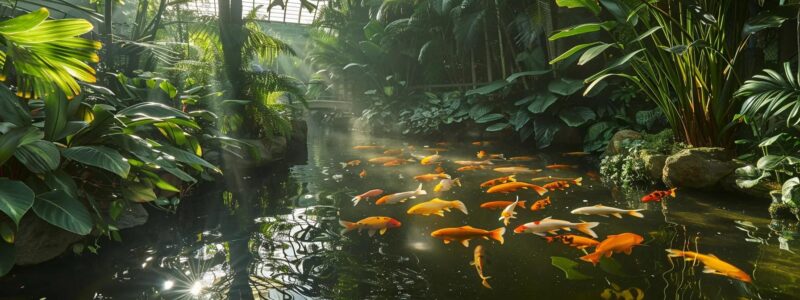
Protecting koi from predators and environmental stress is crucial for maintaining a healthy pond ecosystem in St. Louis. This section covers installing protective netting, creating shelters, using deterrent lighting, controlling plant growth, inspecting for predator signs, and maintaining fish health. These strategies help safeguard koi from various threats while ensuring a thriving pond environment.
Install Netting or Covers to Safeguard Koi
Installing netting or covers is essential for safeguarding koi from predators in St. Louis ponds. Pond owners should select durable, fine-mesh netting that allows light and air circulation while preventing birds and other animals from accessing the water. For optimal protection, the netting should be installed several inches above the water surface and secured tightly around the pond’s perimeter. This precautionary measure not only protects koi from potential threats but also helps reduce debris accumulation, maintaining water quality and reducing maintenance needs:
| Netting Type | Mesh Size | Benefits |
|---|---|---|
| Polyethylene | 1/2 inch | Durable, UV-resistant |
| Nylon | 1/4 inch | Lightweight, easy to install |
| Metal mesh | 1 inch | Extra sturdy, predator-proof |
| Floating covers | N/A | Seasonal protection, heat retention |
Create Shelters in the Pond for Koi to Hide
Creating shelters in koi ponds provides essential hiding spots for fish, reducing stress and protecting them from predators in St. Louis. Pond owners can install submerged structures like PVC pipes, ceramic pots, or specially designed koi castles to offer safe retreats. These shelters should be placed at varying depths throughout the pond, ensuring koi have access to protection regardless of water temperature or oxygen levels. By incorporating natural elements like large rocks or driftwood, pond enthusiasts can create a more aesthetically pleasing environment while offering crucial safety zones for their prized koi.
Use Pond Lighting to Deter Nocturnal Predators
Utilizing pond lighting effectively deters nocturnal predators and protects koi in St. Louis ponds. Pond owners can install motion-activated LED lights around the water’s edge, creating sudden brightness that startles potential threats like raccoons or herons. Underwater lighting not only enhances the pond’s aesthetic appeal but also disorients predators, making it difficult for them to spot koi. For optimal results, pond enthusiasts should position lights strategically, illuminating key areas while maintaining darker zones for fish to retreat.
Control Plant Growth Around the Pond to Reduce Hiding Spots
Controlling plant growth around koi ponds in St. Louis is crucial for reducing potential hiding spots for predators. Pond owners should regularly trim aquatic plants and maintain a clear border around the pond’s edge, creating an open space that makes it difficult for predators to approach undetected. This practice not only enhances visibility but also improves water circulation and oxygenation, benefiting the overall health of the koi. Pond enthusiasts should focus on maintaining a balance between aesthetic appeal and safety, using strategic landscaping techniques to create an environment that is both beautiful and secure for their prized fish:
| Plant Type | Maintenance Frequency | Recommended Distance from Pond Edge |
|---|---|---|
| Tall grasses | Monthly trimming | 3-5 feet |
| Floating plants | Weekly thinning | Cover no more than 1/3 of surface |
| Marginal plants | Bi-weekly pruning | 1-2 feet from edge |
| Submerged plants | Monthly inspection | Maintain clear zones near edges |
Regularly Inspect the Pond for Signs of Predatory Visits
Regular inspection of koi ponds for signs of predatory visits is crucial for protecting fish in St. Louis. Pond owners should look for tracks, droppings, or scattered debris around the pond’s perimeter, which may indicate nocturnal predator activity. Examining the water’s surface for unusual ripples or disturbances can reveal potential threats from birds or mammals. By conducting daily visual checks and maintaining detailed records of any suspicious activity, pond enthusiasts can quickly identify and address potential predator issues, ensuring the safety of their valuable koi.
Maintain Fish Health to Minimize Stress Effects
Maintaining optimal fish health is crucial for minimizing stress effects and protecting koi from predators in St. Louis ponds. Pond owners should implement a comprehensive health management plan that includes regular water quality testing, proper nutrition, and routine veterinary check-ups. By ensuring a balanced diet, stable water parameters, and prompt treatment of any health issues, koi become more resilient to environmental stressors and less susceptible to predation. This proactive approach not only enhances the fish’s overall well-being but also strengthens their immune systems, making them better equipped to handle potential threats in their aquatic environment.
Assess and Manage Pond Plant Life Effectively
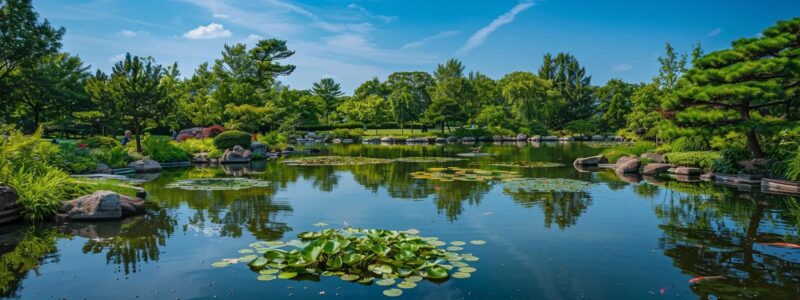
Effective management of pond plant life is crucial for maintaining a healthy koi pond ecosystem in St. Louis. This section covers selecting suitable aquatic plants, regular trimming, monitoring plant health, using floating plants for shade, understanding natural filtration, and avoiding invasive species. Proper plant management ensures optimal water quality and a thriving environment for koi.
Choose Suitable Aquatic Plants for Koi Ponds
Selecting suitable aquatic plants for koi ponds in St. Louis is crucial for maintaining a balanced ecosystem. Pond owners should choose a variety of plants that provide oxygen, shade, and natural filtration while avoiding species that may harm koi. Ideal choices include submerged plants like hornwort, floating plants such as water lettuce, and marginal plants like iris and rushes. These plants not only enhance the pond’s aesthetics but also contribute to water quality and provide hiding spots for koi:
- Submerged plants: Hornwort, Anacharis, Vallisneria
- Floating plants: Water lettuce, Water hyacinth, Duckweed
- Marginal plants: Iris, Rushes, Cattails
- Oxygenating plants: Elodea, Cabomba, Myriophyllum
Regularly Trim Overgrown Plants to Maintain Balance
Regular trimming of overgrown plants is essential for maintaining balance in St. Louis koi ponds. Pond owners should establish a routine pruning schedule, typically every 2-4 weeks during the growing season, to control plant growth and prevent overcrowding. This practice not only enhances the pond’s aesthetic appeal but also ensures proper water circulation, reduces organic debris, and maintains optimal oxygen levels for koi. By carefully managing plant density, pond enthusiasts can create an ideal environment that supports both aquatic flora and fauna:
| Plant Type | Trimming Frequency | Maintenance Tips |
|---|---|---|
| Marginal plants | Bi-weekly | Remove dead leaves, thin out dense growth |
| Floating plants | Weekly | Remove excess coverage, maintain 30-40% surface area |
| Submerged plants | Monthly | Prune to prevent tangling, maintain clear swimming areas |
| Oxygenating plants | As needed | Thin out to prevent overcrowding, maintain proper balance |
Monitor Plant Health to Avoid Decay and Pollution
Monitoring plant health is crucial for preventing decay and pollution in St. Louis koi ponds. Pond owners should regularly inspect aquatic plants for signs of disease, discoloration, or deterioration, promptly removing any affected parts to maintain water quality. This proactive approach helps prevent the buildup of organic matter, which can lead to increased ammonia levels and reduced oxygen content in the pond. By implementing a consistent plant health monitoring routine, pond enthusiasts can ensure a thriving ecosystem that supports both flora and fauna:
- Inspect plants weekly for signs of disease or decay
- Remove dead or yellowing leaves immediately
- Check for pest infestations on floating and marginal plants
- Monitor water clarity and algae growth as indicators of plant health
- Adjust fertilization practices based on plant condition and water quality
Use Floating Plants to Provide Shade and Cover
Utilizing floating plants in St. Louis koi ponds provides essential shade and cover for fish while enhancing water quality. Pond owners can introduce water lilies, water hyacinth, or duckweed to create natural shelter areas, reducing stress on koi and helping to regulate water temperature. These plants also compete with algae for nutrients, effectively controlling algae growth and maintaining clear water. By carefully managing the coverage of floating plants, typically aiming for 30-40% of the pond’s surface, enthusiasts can create an ideal balance between aesthetics and functionality in their koi habitats.
Understand the Role of Plants in Natural Filtration
Understanding the role of plants in natural filtration is crucial for maintaining a healthy koi pond ecosystem in St. Louis. Aquatic plants act as biological filters, absorbing excess nutrients and toxins from the water while producing oxygen through photosynthesis. Pond owners can leverage this natural process by incorporating a variety of submerged, floating, and marginal plants, which work together to create a balanced environment. By carefully selecting and maintaining appropriate plant species, pond enthusiasts can reduce the need for mechanical filtration and create a more sustainable habitat for their koi.
Avoid Invasive Species That Compete With Koi for Resources
Avoiding invasive species is crucial for maintaining a healthy koi pond ecosystem in St. Louis. Pond owners should carefully research and select native or non-invasive aquatic plants, avoiding species like water hyacinths or certain types of duckweed that can quickly overtake the pond. These aggressive plants can outcompete beneficial species, deplete essential nutrients, and create oxygen deficiencies that harm koi. By working with local nurseries or aquatic plant specialists, pond enthusiasts can choose appropriate vegetation that enhances their koi habitat without introducing potentially harmful invasive species.
Conclusion
Effective koi pond maintenance in St. Louis is crucial for creating a thriving aquatic ecosystem that supports healthy fish and vibrant plant life. Regular water quality testing, proper filtration, and consistent cleaning routines form the foundation of a well-maintained koi pond, ensuring optimal conditions for both fish and plants. Providing appropriate nutrition, protecting koi from predators, and managing aquatic vegetation are essential aspects that contribute to the overall health and beauty of the pond. By implementing these comprehensive maintenance techniques, St. Louis pond owners can enjoy the serene beauty of their koi ponds while fostering a balanced and sustainable aquatic environment.

Write a comment: